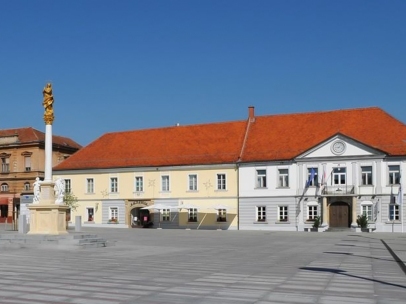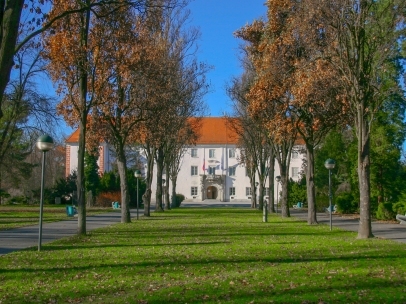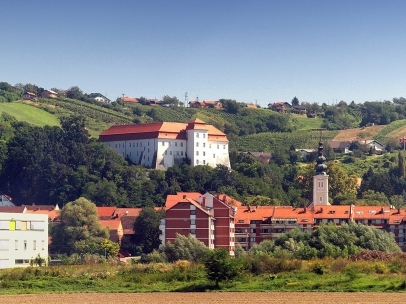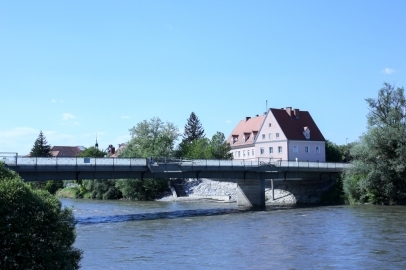Major Cities
- Home
- Activities
- Major Cities

Ljutomer
Ljutomer or Lotmerk, as the locals call it, is the administrative and cultural center of Prlekija, a region on the right bank of the Mura River.
Three squares are located in the city center: Glavni, Stari and Miklošičev trg. On Glavni trg there is a statue of the Immaculate Mary, erected in 1729, on Stari trg you can find Annas chapel from 1756, and on Miklošičev trg the chapel of St. Floriana. In the immediate vicinity is the Parish Church of St. John the Baptist. It houses a tomb in which Rudolf Lasberški, one of the owners of Cven Castle, is buried.
History lovers will be delighted by three museum collections: the General Museum Collection, the Camp Movement in Slovenian and the Collection of Photographs and Films of Dr. Karol Grossmann. The Ljutomer trotter museum and the hippodrome show first horse races in Slovenia. Trotting sports and horse racing left an important mark in the past of Prlekija region. Still today Trotting club Ljutomer organizes eight horse races every year in the summer and brightens up Sunday afternoons.
Pottery also played an important role in this area in the past. Pottery has been produced by the Žuman family for well over a century. Products of family lineages are collected in the Žuman Pottery Museum.
Ljutomer is the oldest center with a wine tradition in this area. The Ljutomerčan wine cellar is known for its excellent white wines, which come from the wine-growing area of the Jeruzalem vineyards.
You will find rest and shade in the hot summer months under the mighty oaks planted in the 19th century in the Park I. Slovenskega tabora, where the idea of a United Slovenia came to life on August 9, 1868. There is also the Ljutomer outdoor Swimming Pool, which is located in the immediate vicinity of the park.
Before you start exploring this modern, cultural and tourist-friendly place, we recommend visiting the Tourist Information Center (TIC) Ljutomer, located on the Glavni trg. There you will get all the information you need to explore the region.

Murska Sobota
Murska Sobota is the administrative and cultural center of Prekmurje, a region on the left bank of the Mura River.
A walk through this lively city can be started at Murska Sobota Castle. The two-story Renaissance manor house with prominent rectangular charcoal towers is first mentioned in 1255, but it acquired its present appearance in the first half of the 18th century. The owners of the castle changed, but in 1934 it became the property of the Municipality of Murska Sobota. Inside, the notable castle salon has been preserved, while the former castle chapel, now a profane place for civil weddings, stands out architecturally. The Pomurje Museum of Murska Sobota is located in the castle, with a permanent exhibition on the history of Prekmurje and thematic exhibitions and programs that take place throughout the year. The castle also houses the MIKK - Youth Information and Culture Club, which is distinguished by its high-quality club and music scene, and otherwise runs a cultural and educational program for young people.
The castle is surrounded by the City Park, which is one of the most beautifully preserved castle parks in Slovenia and covers an area of nine and a half hectares. In terms of the number of trees, it is among the richest in Slovenia, and it also boasts a rich animal world. In the park, we can find a writers bust of Primož Trubar, a monument to teachers who died in World War II, a monument to the first Prekmurje writers, and 19 organized stone lithopunctures. The park is a popular meeting place for young people and a place for many townspeople, especially young families, to relax, as there is a pond and a childrens playground in the immediate vicinity of the castle.
From the castle building, the Trubar tree-lined avenue leads through the park, which, extended by a promenade, leads to the Evangelical Church, which was built in the Neo-Gothic style in 1907-1910.
From the church, we walk through Trg zmage, where the Victory Monument is located, which was erected in honor of Soviet soldiers and Yugoslav partisans. In the immediate vicinity of the square we find Restaurant and pub Zvezda, where you can taste typical Prekmurje dishes in a large shady garden under chestnut trees. The building has a great historical significance, as the Murska republika was proclaimed from the balcony on the first floor on 5/29/1919. Today, documents from that time can be viewed in the salon on the first floor.
We continue our journey towards Trg kulture, where the Murska Sobota Gallery is located, which hosts a permanent collection of contemporary fine art from Pomurje, presents the works of local artists and hosts other exhibitors. In the immediate vicinity is the Provincial and Study Library, which, in addition to the Park Theatre, the Music School, the Murska Sobota School of Economics and the residential and commercial building Sončnica, is a gem of modern architecture in Murska Sobota.
From the library, you can go past the Diana Hotel towards the Cathedral Church of St. Nicholas, whose late Romanesque core with cornice bell tower dates from the end of the 13th century, and was thoroughly rebuilt in 1910-1912.
Many recreation centers and sports facilities are available in town. The sports and recreation center Fazanerija is worth mentioning, where the football club NŠ Mura has its football stadium. In the pleasant, cool shade of the forest, there is a well-maintained trim track, tennis enthusiasts can swing rackets, and the Murska Sobota outdoor Swimming Pool offers pleasant cooling in the summer months. On the other side of town, the Lake Kamešnica invites you to fish and swim. The Expano pavilion is located next to the lake, where you can get to know Pomurje in an interactive way and enjoy traditional Pomurje dishes in the restaurant.
Traditional entertainment events take place in the city center throughout the year. In the month of February Pustovanje, in May Bogračijada and Family Picnic, in June the music festival Soboški dnevi, the whole of July and August Soboško poletje, also in August the international contemporary dance festival Front@, three traditional fairs Trezino senje on October 15, Miklošovo senje on December 6. and the Summer Fair on June 15. From the beginning of June until the end of September, the Sočna vilica street food festival takes place every 14 days. In August the Aeromiting takes place at the sports airport in Rakičan.
Many restaurants and bars invite you to satisfy your hunger and thirst and enjoy meeting friends.
Murska Sobota offers many shops and shopping centers in the city. Some scattered throughout the city, others gathered in larger shopping centers on the outskirts of the city. In the shopping center Maximus there is, among other things, the Cineplexx cinema, bowling and billiards.
In the center of the city is the Tourist Information Center (TIC) Murska Sobota, which is led by the Institute for Culture, Tourism and Sport Murska Sobota, which is the organizer of many events in the city. There you will find all the information you need to explore the town and the region.

Lendava
Lendava is a town in the most north-east part of Slovenia. This end of Prekmurje borders Hungary and Croatia. At the foot of the Lendavske gorice, the Lendava Castle rises above the roofs of the houses and gives the town a typical image. The castle is home to the Lendava Gallery - Museum, where the museum collection houses a permanent archaeological, historical and ethnological exhibition, as well as the memorial room of the famous Lendava sculptor Gyorgay Zala. The gallery collection houses the art heritage of Lendava artists and a collection of works of art created in the context of traditional international colonies.
Until World War II, a strong Jewish community led the development of the town, and the Lendava Synagogue is one of the preserved monuments of that time. It is one of the two remaining Jewish synagogues in Slovenia and today serves as an exhibition and event space.
Also worth visiting are The Jewish cemetery, the Town Hall, the Evangelical church, the parish church of St. Katarine, the Museum of Bourgeoisie, Carpentry and Umbrella Making and the Lendava Theater and Concert Hall.
The Chapel of the Holy Trinity is located in Lendavske Gorice, where the mummy of the military leader Mihael Hadik, who was one of the greatest heroes from the battles with the Turks, is on display.
Vinarium Tower is located in Dolgovaške gorice, about 4 kilometers from Lendava. At 302 meters above sea level, there is a 53.5-meter-high observation tower that offers a unique 360-degree view of the plains and hills of four countries - Slovenia, Hungary, Croatia and Austria. You can go to the highest viewing platform on foot, up 240 steps, or you can take the elevator.
The most recognizable dish of Lendava is bograč. Every year at the end of August, the biggest bograč cooking competition in Slovenia takes place in the old town center of Lendava. The event is called Bogračfest. And in 2011 the president of Slovenia, Danilo Tuerk, declared Lendava the world capital of Bograč.
Also worth mentioning is the traditional ethnological and culinary event Lendavska trgatev. The event is a celebration of winegrowers, which offers a varied all-day program and a rich culinary offer. In a traditional procession through the old town, customs and costumes are presented, and there are also folklore, animation for children and late-night parties.
You will learn more information about attractions and current events in Lendava at the Tourist Information Center (TIC) Lendava, which is located in the center of the town.

Gornja Radgona
This border town is often referred to as the "city of fairs and sparkling wine". The written mention of Radgona as a fair town dates back to 1401. Today, the Pomurski Sejem organizes and hosts international fair events. In addition to fairs, they also organize product evaluations, which take place according to international criteria, so their awards are an important part of the market success of the awarded products.
The Radgonske Gorice produce renowned wines that mature in the cellars of the castle hill. Golden and Silver Radgona sparkling wine have been bottled since 1852. Guided tours of the cellar with tastings are possible.
However, the place is also characterized by other attractions, not only fairs and sparkling wine. The Mura River separates Gornja Radgona from Austrian Bad Radkersburg, but the two places are strongly connected. The Bridge of Frienship is a symbol that connects two places, two languages and two countries.
Radgona Castle stands on a high hill with a beautiful view of the surroundings. On the castle hill, the Church of St. Peter is located. Under the church, in a small square, stands a monument commemorating the 10th anniversary of the war for Slovenias independence. The memorial plaque bears the inscription "Never Again" in three languages.
The permanent museum collection Radgonski mostovi is on display in a uniquely designed building from the beginning of the 17th century, called Špital Museum. In addition to Špital, you can walk past the Alley of the Great, where busts of famous people from Gornja Radgona are set.
The city park with a platform for events, a childrens playground and a water fountain is popular for relaxation and socializing. It is connected to the Trate tourist and sports park, which has various sports areas.
Nature lovers can relax in the Lisjakova Struga Forest Park. This natural pearl by the Mura River is intended for recreation and getting to know the flora and fauna. At the Bridge of Friendship you will find the Tourist Information Center (TIC) of Gornja Radgona, where you can find out more information about the town and its surroundings.


